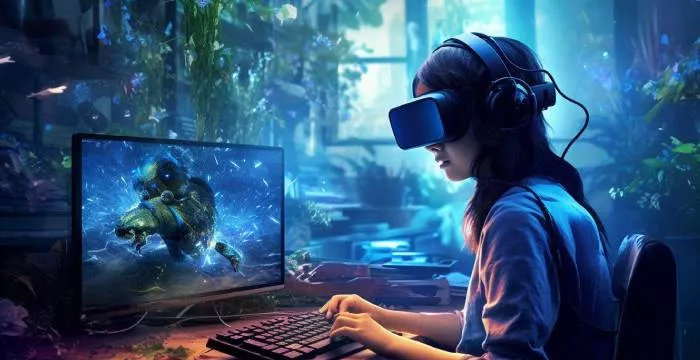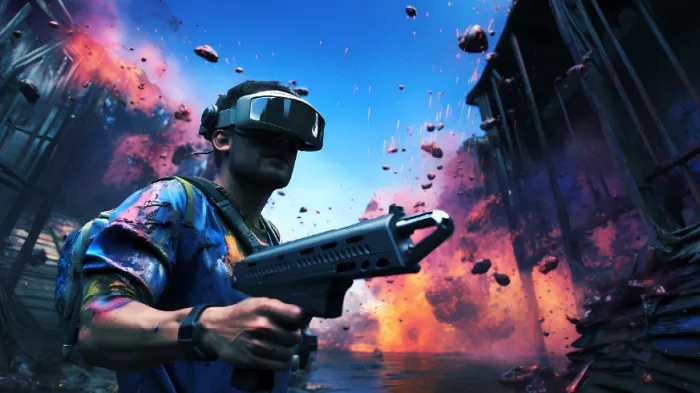
AI is changing gaming at breakneck speed. From believable NPCs to stunning visual worlds, AI systems are helping studios create more immersive and dynamic games than we've ever seen. Thanks to powerful AI services, developers don't need huge in-house AI teams anymore to access cutting-edge tech.
Today's AI systems can do way more than just help with coding or writing text. They can create complex conversation trees, generate high-quality game assets, and even build entire virtual worlds instantly. Platforms like AI/ML API make it super easy to connect these systems to your development workflow through one simple setup.
But getting language and image models from different sources to work together can still be a pain. Every provider does things their own way, with different documentation and login methods. That's where solutions like AI/ML API help out—giving you streamlined access to top-performing tools like DeepSeek, OpenAI, and others without all the usual headaches.
In this piece, we'll look at how developers are using AI services to build smarter, more dynamic games. From dialogue systems powered by language models to concept art created through text-to-image tools, we'll cover real-world examples, point out technical challenges, and show how a unified platform can make everything simpler. Whether you're building a story-heavy RPG or a fast-paced shooter, integrating AI systems isn't just nice to have anymore—it's where game development is headed.
How AI Models Are Transforming Game Worlds

In today's game development, AI systems aren't just tools anymore—they're creative partners. From making NPCs behave more realistically to building worlds on the spot, developers are using AI to bring games to life with way less manual labor.
Language-focused AI systems, especially the big language models, are completely changing how characters talk in games. These AI systems can create character responses that feel natural and adapt in real-time to what players say or do. Instead of being stuck with pre-written dialogue options, games now have flowing conversations that change based on how players behave, their mood, or what they've done before—making every interaction feel personal.
For visuals, text-to-image AI lets designers quickly create concept art and build procedural worlds. A designer can describe something like "a foggy cyberpunk alleyway at night," and the AI spits out a complete visual scene. These AI-powered workflows save tons of time, cut production costs, and help small studios create visuals that look as good as big-budget games.
When you combine language and image generation, you get dynamic storytelling that wasn't possible before. Quests, landscapes, even background lore can be created instantly based on what players decide to do or how the game is unfolding. This mix of different AI types gives developers the freedom to update, expand, and personalize game content without having to redesign everything from scratch.
Plus, platforms like AI/ML API make this whole process smoother by letting developers access multiple AI services from one place. Instead of juggling several complicated integrations, teams can focus on building immersive experiences using the best models out there—all through one simple connection.
As players want richer, more responsive game worlds, AI will stay at the center of next-generation gaming. And with unified access through services like AI/ML API, even small indie teams can harness the full power of these AI systems.
Core Use Cases: Language Models in Gaming
Language models are completely changing how developers create interactive stories and smart characters. By connecting powerful AI systems through platforms like AI/ML API, game studios can add lifelike NPCs, emergent quests, and dynamic storytelling—all without tons of manual work.
One of the biggest game-changers is creating dialogue on the spot. Instead of using pre-written lines, games can use AI systems to generate unique conversations based on what's happening. Players asking the same question might get different answers depending on their past choices, what time it is, or how they're feeling. This creates a sense of realism and surprise that traditional scripting just can't deliver.
Another huge use case is generating quests and backstory content. AI-powered systems can create mission prompts, background stories, or in-world texts as needed. Games like AI Dungeon have already shown what's possible with language models in open-ended storytelling. Recent research by Stanford and Inworld AI even demonstrated AI-powered NPC directors, where AI automatically coordinates character interactions and goals in shared virtual spaces.
NPC behavior scripting is evolving too. Instead of hardcoded reactions, language models can figure out appropriate emotional responses, contextual decisions, or strategic dialogue in real-time. This flexibility creates characters that feel genuinely alive—able to adapt to player decisions or even remember past encounters.
Finally, in-game assistance is becoming really popular. Language models work as smart companions—explaining rules, offering hints, or guiding players through natural conversation. Whether it's a medieval wizard giving spell advice or a sci-fi robot summarizing mission objectives, AI services make it easy to embed these responsive helpers into gameplay.
Thanks to AI/ML API, developers can now add these advanced features without juggling multiple tools or vendors. With unified access to top-tier AI services, teams can streamline development while creating unforgettable gaming experiences.
Core Use Cases: Image Models in Gaming
Just like language models are changing interactive stories, image-based AI systems are transforming how visuals get made in game development. From quick prototyping to full production assets, these tools have become must-haves for both indie and big-budget workflows.
One of the most useful applications is creating concept art. Traditionally, game art teams would spend weeks sketching out early ideas. But with text-to-image creation, developers can now describe a scene—like "post-apocalyptic city at sunset with overgrown vines"—and get back multiple high-quality visual options in seconds. This massively speeds up creative iteration and helps get teams on the same page early in the process.
Another big area is building environments automatically. AI models can create landscapes, structures, and terrain variations with very little input. Artists can then polish these AI-generated outputs instead of building everything from the ground up. Platforms like AI/ML API give you access to high-performance models such as OpenAI Image-1, Google Imagen 4, or Flux, making it easy to integrate advanced visual generation into any workflow.
User interface elements and marketing visuals are increasingly AI-powered too. Game developers now create icons, banners, and promotional artwork using AI systems, saving both time and money. The output isn't just faster—it can be uniquely customized to match changing art directions.
A real example comes from AWS's work with Stability AI, as described in their blog. By integrating Stability's image models through platforms like Amazon Bedrock, developers were able to speed up early-stage asset creation, reduce creative roadblocks, and iterate much faster.
With AI/ML API, developers can access this same power—without having to manage multiple services or deal with model-specific quirks. Whether you're building immersive worlds or creating polished visuals, unified access to cutting-edge AI services opens up a new era of speed and scalability in game art.
Integration Challenges & the Case for Unified APIs
As game studios rush to add AI systems for faster development, a big problem is showing up—managing multiple AI services. Tools like DeepSeek, Grok, and other vendor-specific services all have powerful features, but they don't work well together. This fragmented setup creates friction that slows down even the most nimble teams.
Every provider has its own login method, endpoint setup, and request format. While one model might just need a simple API key, another could involve complex OAuth tokens or session-based logins. Developers end up juggling credentials, managing separate SDKs, and customizing requests for every integration. That alone adds extra risk, especially when working across teams and different environments.
The infrastructure overhead piles up fast. Without a standardized approach, developers have to write and maintain unique code for every AI model they use—whether it's for creating dialogue, building game worlds, or making visuals. This leads to duplicate code, inconsistent workflows, and tons of potential bugs. Scaling becomes tough, and experimenting with different models slows to a crawl.
This is where platforms like AI/ML API provide game-changing value. By offering a unified service, it standardizes requests, normalizes output formats, and centralizes authentication—no matter which provider you're actually using underneath. Whether you're tapping into text generation models or advanced text-to-image systems, everything works through one consistent setup.
For studios looking to move fast, stay flexible, and reduce maintenance headaches, adopting a unified service isn't just convenient—it's essential for long-term scalability and innovation in AI-powered game development.
Leveraging AI/ML API to Power Game Worlds
For game developers building with AI, time and consistency matter most. That's where AI/ML API really delivers. It gives you one simple way to access tons of advanced AI systems—from text generation to image creation—all through one unified setup. Instead of jumping between providers like Mistral, Flux, or Google’s models, teams can work with all of them through one smooth workflow.
With AI/ML API, developers get access to pre-connected AI systems from multiple providers. You don't need to write separate code for different services anymore. This single connection approach means consistent request formats, standardized login, and centralized tracking, no matter which model you pick.
Step-by-Step Integration with AI/ML API:
1. Pick the Right Models Look through the AI/ML API model catalog. For example, you can combine a text model like Claude for quest creation with a visual model like Google Imagen 4 for character concept art.
2. Build Your Workflow Set up your text-to-text and text-to-image processes through the same service. Define prompts, resolution, and content settings within one request format.
3. Connect to Your Game Engine Link your workflow to your game environment—whether you're using Unity, Unreal, or a custom engine. Since all responses follow the same structure, integration is quick and reliable.
4. Improve with Analytics Monitor model usage and performance right in the AI/ML API dashboard. Quickly swap out underperforming models or try A/B testing—all without breaking your integration.
Mixing Dialogue and Visuals One of the coolest things about AI/ML API is combining natural language and image generation in real-time. Picture this workflow:
- A player walks into a new quest area.
- The system uses a language model to create personalized NPC dialogue.
- At the same time, an image model generates a custom background illustration to match the story.
Since both outputs come from the same service structure, developers can easily combine them—creating immersive, responsive game experiences.
Ultimately, AI/ML API lets teams prototype faster, cut development time, and scale creatively without technical roadblocks. Whether you're a solo developer or part of a big studio, building AI-powered game worlds just got way easier.
Future Trends: The Next Level of AI in Games
As AI systems keep getting better, the gaming industry is about to see even more immersive experiences. Interactive video generation will soon let developers create real-time cutscenes that change based on what players do. Meanwhile, real-time world building will allow developers to create environments on the spot, adapting to player decisions without needing pre-written scripts.
Unified AI services like AI/ML API will be crucial for this shift. By giving seamless access to AI systems that handle multiple types of content, they'll support everything from live terrain creation to AI-controlled story pacing. Instead of static game worlds, developers can build games that change dynamically based on how players behave.
Exciting research is already happening with text-to-game engines, which turn natural language into playable content. As these services mature, they'll power an era where storytelling, visuals, and gameplay are created together by humans and machines in real time. The future of gaming isn't just smart—it's generative, adaptive, and fully interactive.
Conclusion: Empowering Game Developers with AI
AI-powered tools are opening up new possibilities for creativity, speed, and growth for game development teams no matter their size. From creating immersive dialogue to designing entire worlds, today's AI systems are changing how games get imagined and built.
With AI/ML API, developers can access top AI systems through one simple connection—making integration easier and boosting productivity.
Whether you're building an indie RPG or expanding a big-budget production pipeline, unified AI services make advanced tools accessible to everyone.
Ready to level up your game development? Start now at aimlapi.com.





Comments